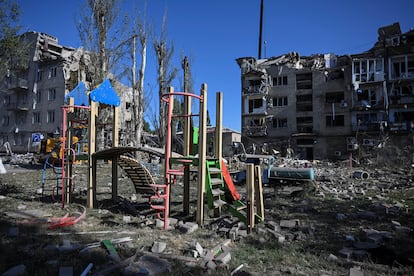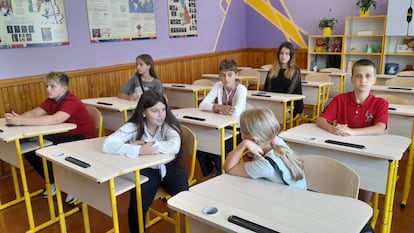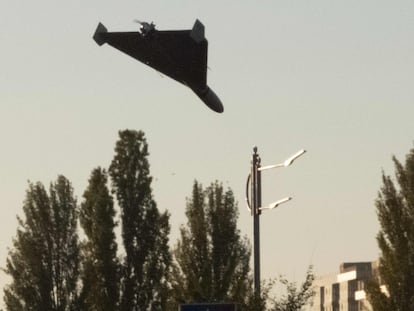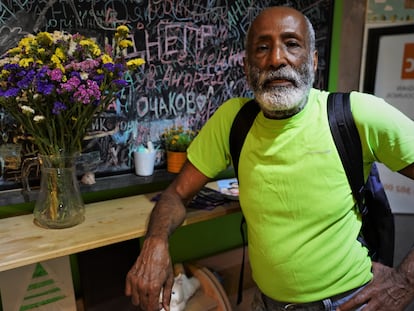Operation: Rebuild liberated Ukraine. Cost: $1 trillion
A year-and-a-half after the Russian invasion began, Ukrainians are striving to fix the damage with a joint response from Kyiv, local governments, civil society, international donors and NGOs


While listening to 73-year-old Nadia Reznik — a native of the village of Kukhari, located an hour from Chernobyl — explain what happened when the Russian armored vehicles arrived on her land, you feel as if you’re listening to the story of the millions of Ukrainians who, one February morning last year, saw their home turned into a trench.
This woman — who has clear eyes and a charming smile — and her husband fled from their beautiful dark wooden house with a gabled roof, as a wave of bombs caused havoc. Her 97-year-old mother, however, didn’t want to leave the village. She chose to stay with some neighbors.
Nadia’s mother has witnessed almost a century of horrors in Ukraine. “I suffered the Holodomor [the Soviet-orchestrated famine of the 1930s, which killed more than three million Ukrainians], the Nazis, and now this,” she laments, before breaking down, crying inconsolably. When her daughter returned home with her husband, Sasha, last summer, the destruction of the roof and windows was compounded by the theft of belongings. “We made basic repairs and we left again — this time with my mother — to avoid the winter,” Nadia says.
The figures related to the daily Russian bombardments over large parts of Ukrainian territory are jarring. The latest report from the Kyiv School of Economics (KSE) — published in June of this year — notes that there are at least 167,200 damaged properties (houses, apartment buildings, etc.), worth about €51 billion or $56 billion. Another $35 billion worth of airports, train stations and 15,000 miles of road have also been ruined, as have 3,400 schools — damaged or destroyed at a cost of about $10 billion — along with the country’s energy infrastructure, at a cost of over $8 billion. This includes the Nova Kajovka dam, which alone cost about $600 million to rebuild.
Olga, 67, was less fortunate than Nadia Reznik’s family. After a projectile hit her house in the town of Kukhari, it was almost completely destroyed. Thankfully, she wasn’t inside at the time. “[The district] commission came and concluded that my house couldn’t be repaired,” she sighs. However, thanks to support from the United Nations High Commissioner for Refugees (UNHCR) — which also provided assistance to Reznik — Olga found a dignified solution: a modular home, which has a kitchen and bathroom. It’s located two steps from what remains of her old home, so she didn’t have to move. “I should build a new house, but it’s not possible.” There’s no budget. At least, Olga points out, she has space for her daughter and grandchildren. And for Simba, her beloved cat.

Volodymyr Zelenskiy’s administration shared the total monetary amount of damages with the World Bank back in March: it stands at around €383 billion, or $417 billion. Ukrainian companies have also paid the price of the Russian invasion and occupation, having lost about $12 billion in assets, according to the KSE.
Oleksandr Griban, 42, was Ukraine’s deputy minister of economy until a few weeks ago. He now works at UNIT.City — the first Ukrainian innovation park. He is one of the people who best knows the ins and outs of this huge rebuilding operation. He admits that the estimate provided to the World Bank could have fallen short. “[The damage] could have reached $1 trillion,” he says. “Even if we compare this to the Marshall Plan [the U.S. aid program to Europe post-World War II] — which would have been approximately $300 billion in today’s money — we are now at $1 trillion.”
Griban acknowledges that Ukraine needs help, but not forever. “We can’t depend on aid too much.” He speaks of a “new beginning,” where not only is the Ukrainian government able to pay wages to teachers, doctors and soldiers, but is also capable of generating economic activity. This is no easy task after the massive damage to agriculture, energy, hydrocarbons, logistics and transport, the service sector, construction and information technology. But there are still opportunities.
“We have a huge territory, a lot of agricultural land,” this financial expert emphasizes. “And we don’t consume more than 30% of what we produce, so we can afford to reallocate a part of this territory to renewable energy. Ukraine can be the power plant of Europe, even the renewable power plant.”
Return to normalcy
At first glance, the pace of reconstruction work isn’t frantic, but things are chugging along. Just over five miles from Kuhari is the municipality of Olyva. Valentina Ilnitska, 59, and Yulia Ivashko, 56, once worked in the library of the cultural center of this town. And they will continue to do so, after it’s rebuilt.
They come to check out how the roofers are doing. The new windows have already been installed, but — according to Rokada, a local organization that supports repair work alongside the UNHCR — there’s an issue with the electrical installation.
“Here, in the town center, every day was a holiday,” Ilnitska recalls. “We were always commemorating something: the anniversary of Chernobyl, the day of independence….” They want to get all of that back.
Two days after the start of the offensive in February 2022, Russian tanks reached Olyva. It became a battlefield where Ukrainian and Russian artillery fire was exchanged. Three missiles fell next to the cultural center and destroyed almost everything. “There are a lot of kids from the area who have nothing else to do but come here,” Ivashko says. The reconstruction of Ukraine involves restoring the physical space that the war destroyed, but also — as in the case of this social space in Olyva — recovering normality.
When asked if she’s pleased with the progress of the rebuilding process, Ilnitska nods. “It’s normal. First, we remove the rubble. Then, we find the materials. After that, we start to repair.”
The reconstruction of the country is complex. The first stage — after the invader’s forces fled — was damage assessment. Subsequently, some debris was cleared and the first private repairs were carried out, so that residents could face the winter. After this, the process of wide-scale reconstruction was developed. The change is obvious: when this correspondent visited the periphery of Kyiv a year ago, the image of towns such as Irpin, Bucha or Borodianka was that of a recent crime scene. Victims felt paralyzed and frustrated. Today, however, the remains of the horror have been cleaned up. Scaffolding is everywhere, holes are covered, while whatever could be salvaged is being restored. Of course, there’s still much more to be done.
Officials at the Ukrainian Ministry of Infrastructure explain that the country’s administration is heavily decentralized. Hence, a community such Kukhari must decide to rebuild one school and not another; if a town wants to have a large clinic rather than two small ones, or vice versa, these decisions are made independently. If a regional jurisdiction has the money, they can move ahead with a project — if they don’t, they can receive support from the federal government. This setup must be taken into consideration by the long-term plan developed by the Ministry of Economy in collaboration with the European Union. Donations will play a big part in the recovery. At the Ukraine Recovery Conference, held this past June in London, more than €60 billion — or $66 billion — were pledged to Ukraine by EU member states and the U.S. government.
Returning to the classroom
Halfway between Borodianka and Bucha is the town of Nemishayevo. As soon as the hostilities began in Hostomel — some eight miles away — several residents of Nemishayevo sheltered in the basement of the main school.
Alina Fedorenko, 49, is the director. She says that they welcomed about 400 people into the school, so that they could have food and warmth. There were older people, but also families of some of the students. “On March 3, the Russians bombed the school and blew out the doors and windows,” Fedorenko recalls. There were five artillery shells. The invading troops — who had positioned themselves nearby — knew that there were people in the basement. They would pass by on occasion and open fire. They killed a volunteer.

Fedorenko shows EL PAÍS photos of how they lived during those weeks. She stops with an energized look when she comes to the snapshot of the Ukrainian soldiers who came to the rescue. From there began a very particular kind of reconstruction. This restoration of the school set a precedent for the reconstruction of institutions across Ukraine. The Ministry of Education changed the windows; Unicef, the U.N. agency for children, transformed the bomb shelter into an underground center, suitable for holding classes in the event of an anti-aircraft alert. And then, the mothers and fathers of the students pitched in with their own money and time. They came up with the idea of covering up the hundreds of bullet holes outside the facility with little stars.
According to data provided by Unicef, 5.3 million Ukrainian children encounter some type of difficulty in accessing education, while 3.6 million have been affected by the closure of schools. “As soon as the internet reconnected,” Fedorenko explains, “we located the children and teachers and started online classes.” All that was left was fixing up the building, so that the school’s 600 students could return to in-person instruction. However, Kyiv imposed a condition: every school must have a new bomb shelter. “Our normality,” says Olena Vorovitska, a 45-year-old teacher at the school, “is to comply with safety regulations, so that, if there’s a siren, we can go down to the shelter.”
The kids can make it down there in eight minutes. A few of them — ranging from the age of eight to 12 — are named Tamerlan, Czarina, Sasha, Artem and Rima. The imprint of the war that the Russians left on them — either by forcing them to flee or stay hidden in a cellar — has all but disappeared, thanks to the tremendous efforts of many different actors.
Downstairs, the shelter is a colorful, childlike, bright and safe space. It’s no longer the dark hole that it was before… although that drab place saved so many lives. Even so, despite the renovation, many children don’t like having to go down there. They think that the missiles that fly through the air after the sirens sound can reach “where people live.” Again.
Sign up for our weekly newsletter to get more English-language news coverage from EL PAÍS USA Edition
Tu suscripción se está usando en otro dispositivo
¿Quieres añadir otro usuario a tu suscripción?
Si continúas leyendo en este dispositivo, no se podrá leer en el otro.
FlechaTu suscripción se está usando en otro dispositivo y solo puedes acceder a EL PAÍS desde un dispositivo a la vez.
Si quieres compartir tu cuenta, cambia tu suscripción a la modalidad Premium, así podrás añadir otro usuario. Cada uno accederá con su propia cuenta de email, lo que os permitirá personalizar vuestra experiencia en EL PAÍS.
¿Tienes una suscripción de empresa? Accede aquí para contratar más cuentas.
En el caso de no saber quién está usando tu cuenta, te recomendamos cambiar tu contraseña aquí.
Si decides continuar compartiendo tu cuenta, este mensaje se mostrará en tu dispositivo y en el de la otra persona que está usando tu cuenta de forma indefinida, afectando a tu experiencia de lectura. Puedes consultar aquí los términos y condiciones de la suscripción digital.
More information
Archived In
Últimas noticias
Alain Aspect, Nobel laureate in physics: ‘Einstein was so smart that he would have had to recognize quantum entanglement’
Imelda Castro, the woman who wants to rule the cartel battleground of Sinaloa
The new victims of the Republican war on Obamacare: Millions hit by soaring health insurance premiums
A country divided on migrant rights: Some US states expand protections while others restrict them
Most viewed
- David King, chemist: ‘There are scientists studying how to cool the planet; nobody should stop these experiments from happening’
- Reinhard Genzel, Nobel laureate in physics: ‘One-minute videos will never give you the truth’
- Oona Chaplin: ‘I told James Cameron that I was living in a treehouse and starting a permaculture project with a friend’
- Sinaloa Cartel war is taking its toll on Los Chapitos
- Mexico completes its trade shift with the entry into force of tariffs on China and countries without trade agreements










































